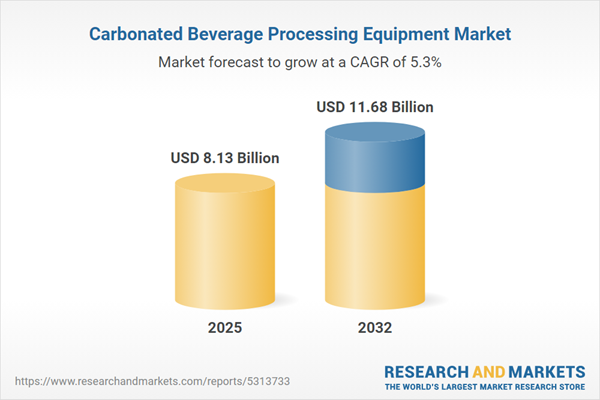Speak directly to the analyst to clarify any post sales queries you may have.
The Carbonated Beverage Processing Equipment Market is undergoing significant transformation, driven by technological advancements, evolving consumer preferences, and global supply chain shifts. Senior leaders in the beverage manufacturing sector face a landscape shaped by innovation, operational agility, and emerging regulatory requirements.
Market Snapshot: Carbonated Beverage Processing Equipment Market
The Carbonated Beverage Processing Equipment Market grew from USD 7.72 billion in 2024 to USD 8.13 billion in 2025. It is expected to continue growing at a CAGR of 5.31%, reaching USD 11.68 billion by 2032. This growth is fueled by shifting consumer demands, increased focus on efficient production, and the need for agility across global beverage segments.
Scope & Segmentation Overview
This research offers a comprehensive analysis of the carbonated beverage processing equipment sector, structured to support strategic decisions on investment and market expansion. The report covers the following core segmentation areas:
- Equipment Types: Capping machines (crown, screw, snap-on); carbonators (batch, inline); filling machines (gravity, pressure, volumetric); labeling machines (pressure sensitive, sleeve, wrap-around); packaging machines (case packers, palletizers, shrink wrappers)
- Operation Modes: Automatic, semi-automatic, manual
- Technology Options: Mechanical carbonation (piston and rotor); pressure carbonation (dynamic and static pressure systems)
- Material Types: Stainless steel, alloy steel, engineered plastics
- End Users: Craft breweries, large-scale breweries, cola and non-cola manufacturers, spirit producers
- Distribution Channels: Direct sales, distributor networks
- Regional Coverage: Americas (United States, Canada, Mexico, Brazil, Argentina, Chile, Colombia, Peru); EMEA (UK, Germany, France, Russia, Italy, Spain, Netherlands, Sweden, Poland, Switzerland, UAE, Saudi Arabia, Qatar, Turkey, Israel, South Africa, Nigeria, Egypt, Kenya); Asia-Pacific (China, India, Japan, Australia, South Korea, Indonesia, Thailand, Malaysia, Singapore, Taiwan)
Specialized segments, such as modular machinery or energy-efficient lines, are increasingly relevant. Regulatory frameworks and distinct consumer preferences across major regions also influence equipment design and procurement strategies.
Key Takeaways for Senior Decision-Makers
- Automation and digital monitoring are advancing operational efficiency, facilitating predictive maintenance, and optimizing line performance through real-time analytics and IoT integration.
- Shifting consumer trends—like demand for healthier, premium, and craft beverages—drive the adoption of flexible, modular processing systems that support small-batch production and rapid changeover.
- High expectations for product safety and quality highlight the importance of robust hygiene standards and reliable fill accuracy in equipment selection.
- Sustainable design choices, such as low water and energy consumption, not only support environmental commitments but also improve long-term operational costs.
- Agility in supply chain management, including the diversification of sourcing and local assembly, is vital for mitigating risks related to tariffs and regulatory shifts.
- Differentiation is increasingly shaped by after-sales technical support, remote diagnostics capabilities, and comprehensive training programs for end-user teams.
Tariff Impact and Supply Chain Strategies
In 2025, new tariff measures in the United States shifted the cost structures for imported processing equipment and spare parts. Market players responded by adapting supplier relationships, evaluating nearshoring options, and realigning assembly operations to reduce tariff exposure. The adoption of local service centers and warehouse hubs enables more reliable service and mitigates the risk of extended downtime, supporting business continuity amid regulatory change.
Methodology & Data Sources
The analysis combines secondary research—drawing from technical journals, reports, and regulatory publications—with targeted interviews of OEM executives, production managers, procurement specialists, and engineering consultants. Analytical methods applied include SWOT analysis, Porter’s Five Forces, and trend impact matrices. Data triangulation and subject matter expert validation underpin the credibility of findings.
Why This Report Matters
- Enables informed investment decisions by mapping out critical market drivers and innovation trends across technologies and regions.
- Supports operational planning by clarifying regulatory, supply chain, and end-user requirements relevant to the carbonated beverage processing equipment market.
Senior leaders benefit from actionable intelligence that aligns capital deployment with evolving market realities.
Conclusion
Stakeholders who prioritize adaptive innovation, resilient supply chain strategies, and data-driven equipment investments are best positioned to capture market opportunities and respond to future disruptions in the carbonated beverage processing equipment sector.
Additional Product Information:
- Purchase of this report includes 1 year online access with quarterly updates.
- This report can be updated on request. Please contact our Customer Experience team using the Ask a Question widget on our website.
Table of Contents
3. Executive Summary
4. Market Overview
7. Cumulative Impact of Artificial Intelligence 2025
Companies Mentioned
The companies profiled in this Carbonated Beverage Processing Equipment market report include:- A DUE di Squeri Donato & C. S.p.A.
- A. Water Systems S.r.l.
- Ajinomoto Co., Inc.
- Alfa Laval AB
- Alpes Industries Services International Ltd
- BAJAJ PROCESSPACK LIMITED
- Bucher Industries AG
- Centec GmbH
- Central States Industrial Equipment & Service, Inc.
- Equipments Machines
- GEA Group Aktiengesellschaft
- Jiangsu ASG Packaging Machinery Group co, Ltd.
- John Bean Technologies Corporation
- KHS GmbH
- Krones AG
- Mojonnier USA, LLC
- Omnia Della Toffola SpA
- Pentair plc
- Seppelec S.L
- SPX Flow, Inc.
- Statco Engineering and Fabricators, Inc.
- TCP Pioneer Co. Ltd
- Tetra Laval Group
- Zhangjiagang King Machine Co., Ltd.
Table Information
| Report Attribute | Details |
|---|---|
| No. of Pages | 197 |
| Published | November 2025 |
| Forecast Period | 2025 - 2032 |
| Estimated Market Value ( USD | $ 8.13 Billion |
| Forecasted Market Value ( USD | $ 11.68 Billion |
| Compound Annual Growth Rate | 5.3% |
| Regions Covered | Global |
| No. of Companies Mentioned | 25 |









